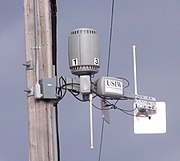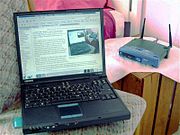History of radio § Broadcasting
Data communications
Wireless Networking: Automated
radio links which transmit digital data between computer and other wireless
devices using radio waves, linking the devices together transparently in a
computer network. Computer networks can transmit any form of data: in addition
to email and web pages, they also carry phone call audio, and video
content Security is more of an issue for wireless networks than for wired
networks since anyone nearby with a wireless modem can access the signal and
attempt to log in. The radio signals of wireless networks are encrypted using
WPA.

Wireless LAN:
based on the IEEE802.11 standards,
these are the most widely used computer networks, used to implement local area network without cables, linking computers, laptops, cell
phones, video game consoles, smart TV and printers in a home or
office together, and to a wireless router connecting them to the internet with a wire or cable connection. Wireless routers in
public places like libraries, hotels and coffee shops create wireless access points (hotspots) to allow the
public to access the Internet with portable devices like smart phones, tablets or laptop. Each device
exchanges data using a wireless modem (wireless network interface controller), an automated microwave transmitter
and receiver with an omni directional antenna that works in the background, exchanging data packets with the
router. WiFi uses channels in the 2.4 GHz and 5 GHz ISM bands with OFDM (orthogonal frequency division
multiplexing) modulation to
transmit data at high rates. The transmitters in Wifi modems are limited to a
radiated power of 200 mW to 1 watt, depending on country. They have a
maximum indoor range of about 150 ft (50 m) on 2.4 GHz and
50 ft (20 m) on 5 GHz.




Comments
Post a Comment